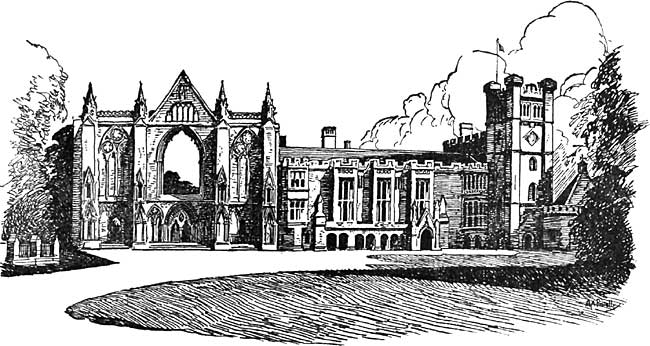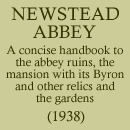Newstead Abbey

Newstead Abbey.
INTRODUCTION
THIS book is intended to serve as a handy guide for the use of visitors to Newstead. For that reason, it does not attempt to be a history of the Abbey; the records of the past—long and rich as that past has been—have been compressed into the briefest possible summary, so as to leave practically the whole space available for the description and illustration of what may be seen at the present day. Much could have been written about events of the distant past that have given Newstead a firm place in the history of England, and interesting accounts could have been given of treasures formerly here which have since been lost to Newstead. But practical utility has been uppermost in the mind of the writer, and this book thus supersedes all previous guides to Newstead, for the latter were compiled before the present arrangement of the Byron relics and other details of Newstead Abbey was made and are therefore out of date. A new era in the long history of Newstead was opened on 16th July, 1931, when the portion of the Abbey detailed in these pages, its grounds and the Byron Furniture, after having experienced many changes of recent ownership, passed into the hands of the Corporation of Nottingham by the generous gifts of Sir Julien Cahn and Mr. C. I. Fraser. Henceforth this precious shrine of monastic and literary history and the Byron Furniture are assured of permanent preservation as a public possession. This change of regime was naturally an event of prime importance to the city and county of Nottingham ; but in the wider sense it was of importance to the nation, for the poet Byron belongs to the first rank of British literary genius and the preservation of his old home and personal belongings under conditions which made it accessible to visitors from all parts of the country—and indeed of the world—was a matter of national interest. Nor did the significance of Sir Julien Cahn's and Mr. Fraser's gifts stop there; it had also its international aspect, and the event of 16th July, 1931, was held of sufficient import to draw to Newstead one of the most famous European statesmen of our time—M. Venizelos, Prime Minister of Greece, who travelled thus far to perform the opening ceremony in recognition of the Greek nation's admiration of and gratitude to Lord Byron as a champion of their own liberties. M. Venizelos, in his speech quoted Lord Morley's estimate of Byron: "History will never forget Byron, because he dealt with the great cause of human events and showed his practical zeal in good and noble causes; he was the most enormous force in his time and in the last great episode of his own career, Byron was as lofty as the noblest side of his creed."
Here, at Newstead, we may see to-day many memorials of this great Englishman—the house in which he lived, the room in which he dined, the table at which he wrote, the bed in which he slept, the gardens in which he walked and mused, the oak tree which he planted, the tomb of his well-beloved dog, and many smaller relics of his life and work.
But in seeing all these we ought to remember that they represent, after all, only one aspect and period of Newstead ; they survive in company with many other memorials of far earlier days, taking us right back to the tragedy of Canterbury in the twelfth century, when Archbishop Thomas a Becket was slain at the altar of his own cathedral.
The larger part of the story of Newstead, as told in the lovely architectural remains we see to-day, is a chapter in the history of medieval England.
 |
Byron. |
Editor's Note.—Since this guide book was written, the Abbey has been further enriched by being made the permanent home of the Roe-Byron Collection, bequeathed to the City of Nottingham by the late Herbert Charles Roe. The Collection is fully described in a catalogue (188 pages) on sale at the Abbey, price two shillings.
